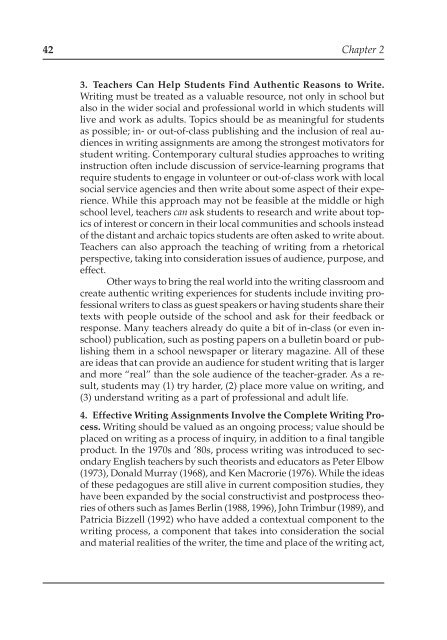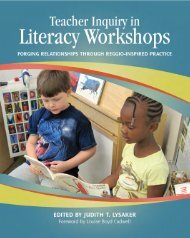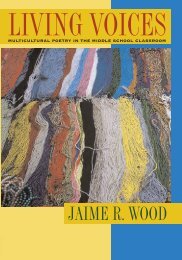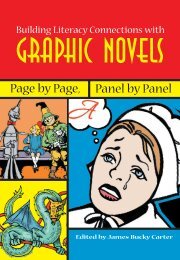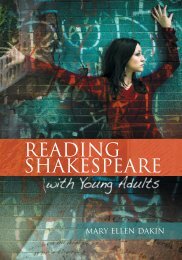2 Narratives about Teaching Writing - National Council of Teachers ...
2 Narratives about Teaching Writing - National Council of Teachers ...
2 Narratives about Teaching Writing - National Council of Teachers ...
- No tags were found...
Create successful ePaper yourself
Turn your PDF publications into a flip-book with our unique Google optimized e-Paper software.
42 Chapter 23. <strong>Teachers</strong> Can Help Students Find Authentic Reasons to Write.<strong>Writing</strong> must be treated as a valuable resource, not only in school butalso in the wider social and pr<strong>of</strong>essional world in which students willlive and work as adults. Topics should be as meaningful for studentsas possible; in- or out-<strong>of</strong>-class publishing and the inclusion <strong>of</strong> real audiencesin writing assignments are among the strongest motivators forstudent writing. Contemporary cultural studies approaches to writinginstruction <strong>of</strong>ten include discussion <strong>of</strong> service-learning programs thatrequire students to engage in volunteer or out-<strong>of</strong>-class work with localsocial service agencies and then write <strong>about</strong> some aspect <strong>of</strong> their experience.While this approach may not be feasible at the middle or highschool level, teachers can ask students to research and write <strong>about</strong> topics<strong>of</strong> interest or concern in their local communities and schools instead<strong>of</strong> the distant and archaic topics students are <strong>of</strong>ten asked to write <strong>about</strong>.<strong>Teachers</strong> can also approach the teaching <strong>of</strong> writing from a rhetoricalperspective, taking into consideration issues <strong>of</strong> audience, purpose, andeffect.Other ways to bring the real world into the writing classroom andcreate authentic writing experiences for students include inviting pr<strong>of</strong>essionalwriters to class as guest speakers or having students share theirtexts with people outside <strong>of</strong> the school and ask for their feedback orresponse. Many teachers already do quite a bit <strong>of</strong> in-class (or even inschool)publication, such as posting papers on a bulletin board or publishingthem in a school newspaper or literary magazine. All <strong>of</strong> theseare ideas that can provide an audience for student writing that is largerand more “real” than the sole audience <strong>of</strong> the teacher-grader. As a result,students may (1) try harder, (2) place more value on writing, and(3) understand writing as a part <strong>of</strong> pr<strong>of</strong>essional and adult life.4. Effective <strong>Writing</strong> Assignments Involve the Complete <strong>Writing</strong> Process.<strong>Writing</strong> should be valued as an ongoing process; value should beplaced on writing as a process <strong>of</strong> inquiry, in addition to a final tangibleproduct. In the 1970s and ’80s, process writing was introduced to secondaryEnglish teachers by such theorists and educators as Peter Elbow(1973), Donald Murray (1968), and Ken Macrorie (1976). While the ideas<strong>of</strong> these pedagogues are still alive in current composition studies, theyhave been expanded by the social constructivist and postprocess theories<strong>of</strong> others such as James Berlin (1988, 1996), John Trimbur (1989), andPatricia Bizzell (1992) who have added a contextual component to thewriting process, a component that takes into consideration the socialand material realities <strong>of</strong> the writer, the time and place <strong>of</strong> the writing act,


